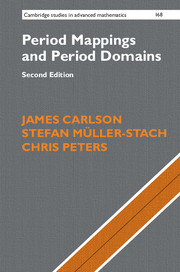Book contents
- Frontmatter
- Contents
- Preface to the Second Edition
- Preface to the First Edition
- PART ONE BASIC THEORY
- PART TWO ALGEBRAIC METHODS
- PART THREE DIFFERENTIAL GEOMETRIC METHODS
- PART FOUR ADDITIONAL TOPICS
- Appendix A Projective Varieties and Complex Manifolds
- Appendix B Homology and Cohomology
- Appendix C Vector Bundles and Chern Classes
- Appendix D Lie Groups and Algebraic Groups
- References
- Index
Preface to the Second Edition
Published online by Cambridge University Press: 30 August 2017
- Frontmatter
- Contents
- Preface to the Second Edition
- Preface to the First Edition
- PART ONE BASIC THEORY
- PART TWO ALGEBRAIC METHODS
- PART THREE DIFFERENTIAL GEOMETRIC METHODS
- PART FOUR ADDITIONAL TOPICS
- Appendix A Projective Varieties and Complex Manifolds
- Appendix B Homology and Cohomology
- Appendix C Vector Bundles and Chern Classes
- Appendix D Lie Groups and Algebraic Groups
- References
- Index
Summary
In the fourteen years since the first edition appeared, ample experience with teaching to graduate students made us realize that a proper understanding of several of the core aspects of period domains needed a lot more explanation than offered in the first edition of this book, especially with regards to the Lie group aspects of period domains.
Consequently, we decided a thorough reworking of the book was called for. In particular Section 4.3, and Chapters 12 and 13 needed revision. The latter two chapters have been rearranged and now contain more, often completely rewritten sections. At the same time relevant newer developments have been inserted at appropriate places. Finally we added a new “Part Four” with additional, more recent topics. This also required an extra Appendix D about Lie groups and algebraic groups.
Let us be more specific about the added material. There is a new Section 5.4 on counterexamples to infinitesimal Torelli. In Chapter 6 the abstract and powerful formalism of derived functors has been added so that for instance the algebraic treatment of the Gauss–Manin connection could be given, as well as a proper treatment of the Leray spectral sequence. In Chapter 13 we have devoted more detail on Higgs bundles and their logarithmic variant. This made it possible to also include some geometric applications at the end of that chapter.
“Part Four” starts with a chapter explaining the by now standard group theoretic formulation of the concept of a Hodge structure. This naturally leads to Mumford–Tate groups and their associated domains. The chapter culminates with a result giving a factorization of the period map which stresses the role of the Mumford–Tate group of a given variation. In Chapter 16 Mumford– Tate domains and their quotients by certain discrete groups, the Mumford–Tate varieties, are considered from a more abstract, axiomatic point of view. In this chapter the relation with the classical Shimura varieties is also explained. In the next and final chapter we study various interesting subvarieties of Mumford– Tate varieties, especially of low dimension.
One word about the prerequisites. Of course, they remain the same (see page xi), but we should mention a couple of more recent books that may serve as a guide to the reader.
- Type
- Chapter
- Information
- Period Mappings and Period Domains , pp. ix - xPublisher: Cambridge University PressPrint publication year: 2017



